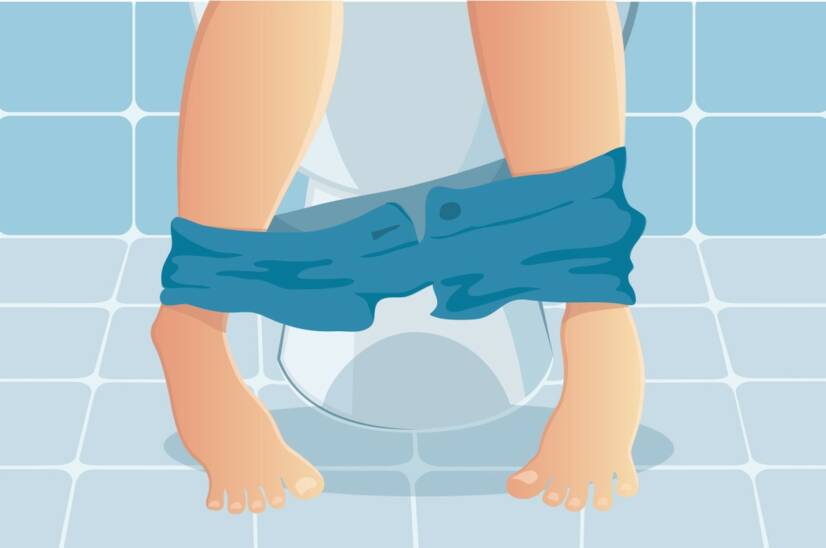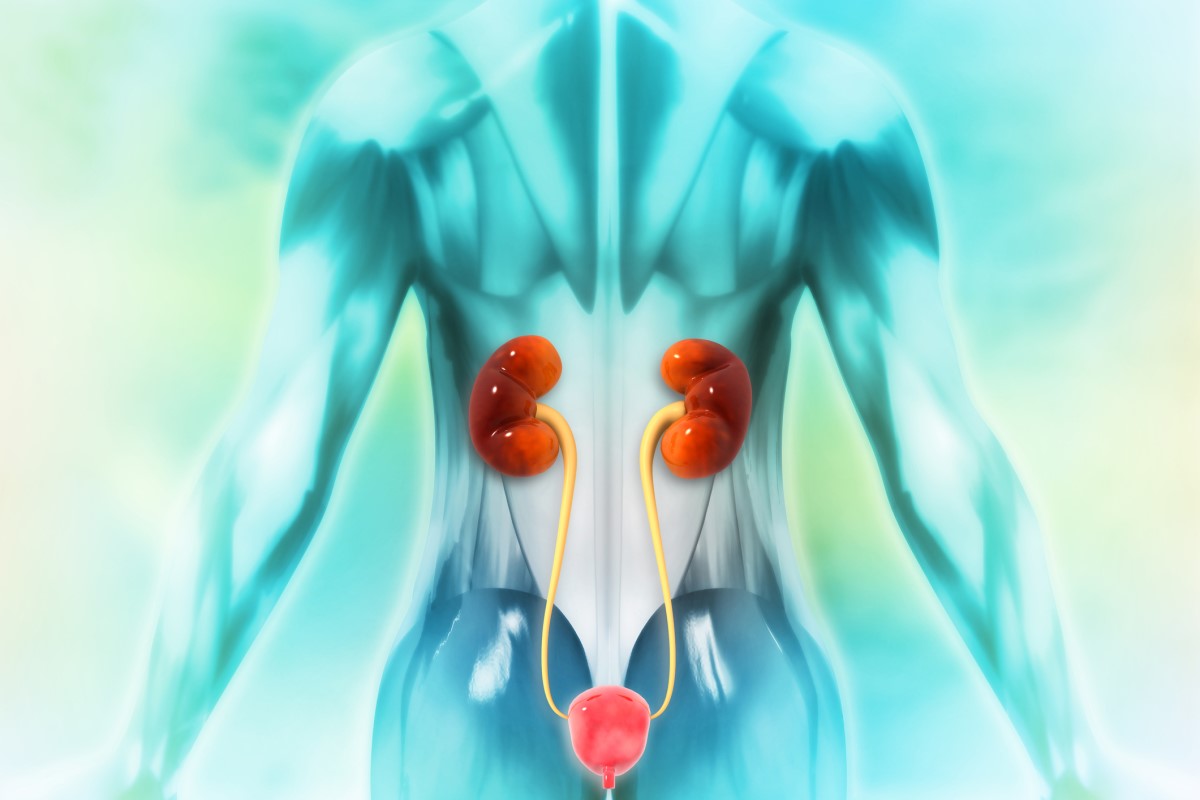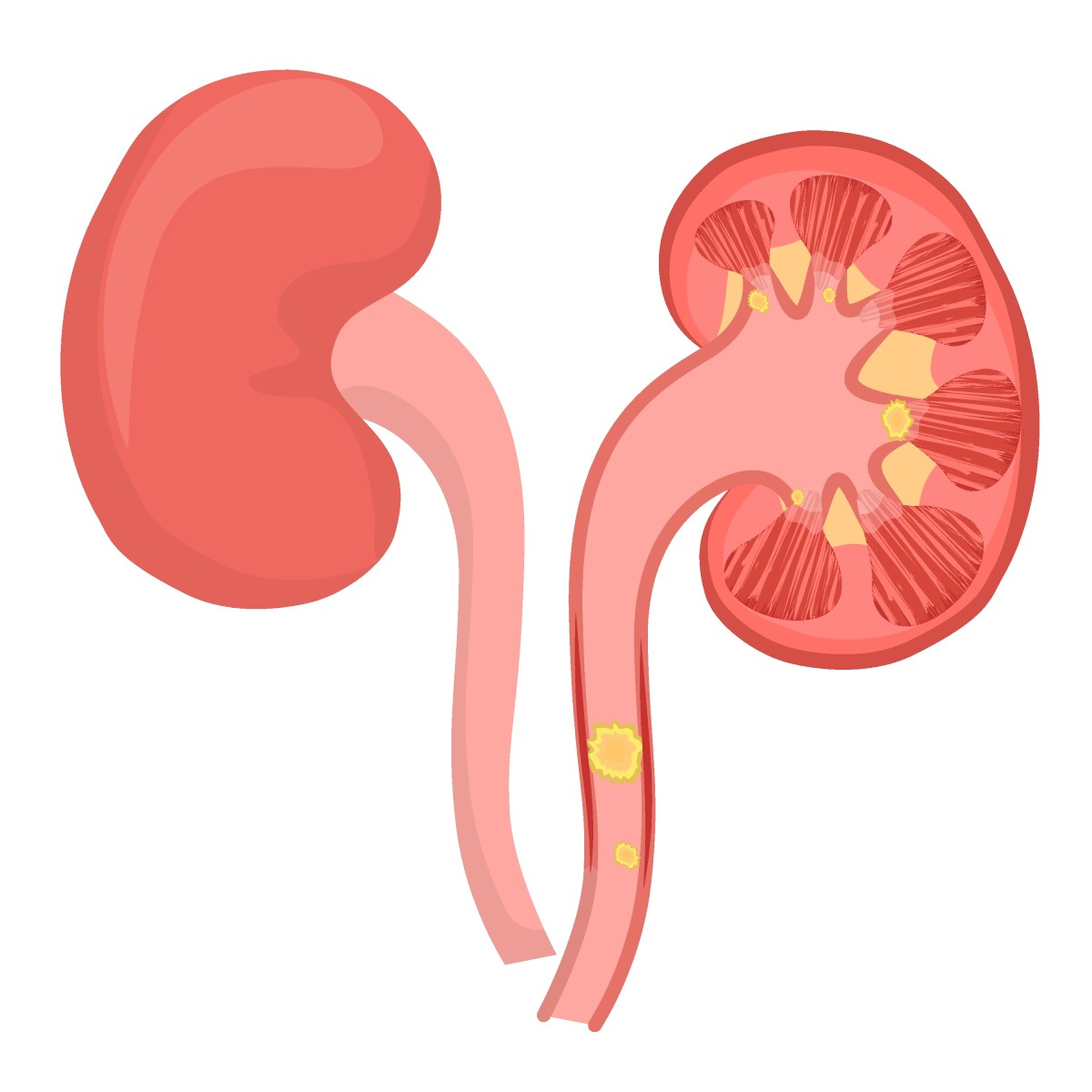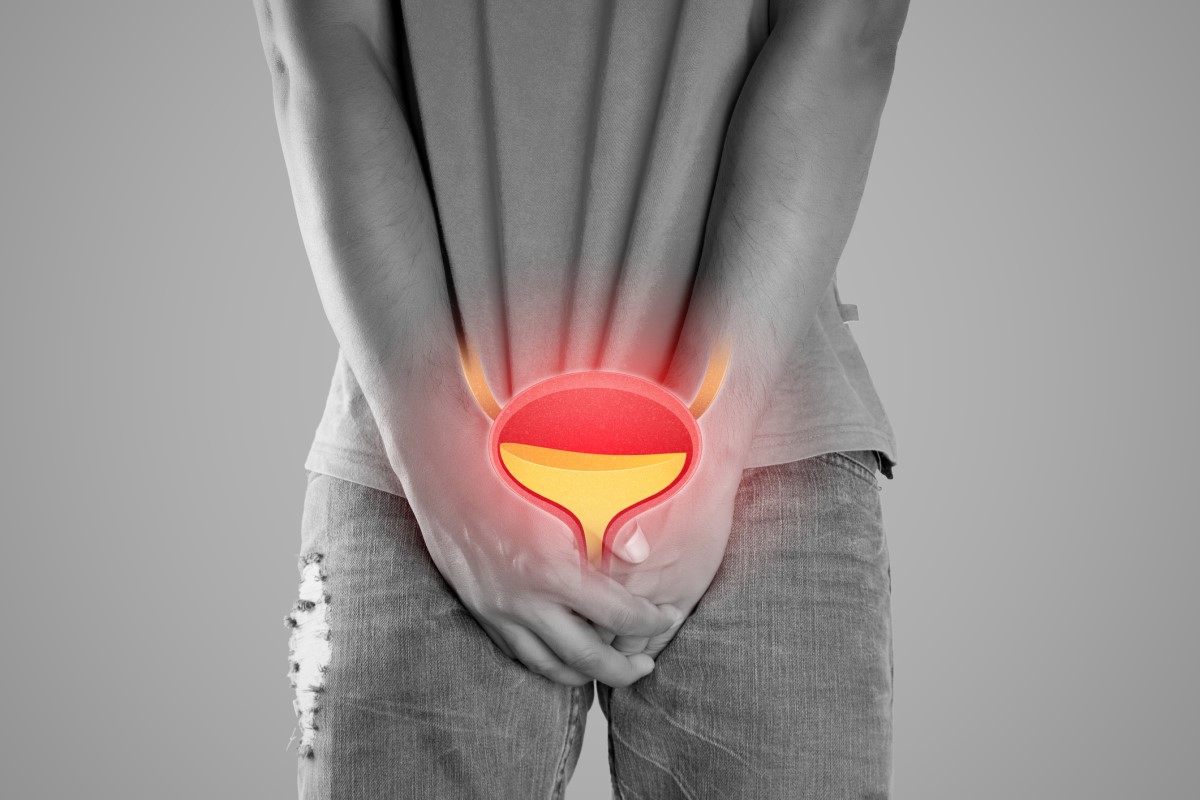- Clinical Propedeutics in Emergency Medicine: Dobiáš Viliam
- Disease signs and symptoms: differential diagnostics: Lukáš Karel, Žák Aleš, a kolektiv
- Unipo.sk - Urology
- zona.fmed.uniba.sk - Acute renal failure
- niddk.nih.gov - Urinary Retention
- clevelandclinic.org - Urinary Retention
- healthline.com - What Causes Urinary Retention, and How Is It Treated?
- healthline.com - Anuria
Urinary retention: what is anuria, obstruction and urinary retention?

Any urinary disorder, such as urinary cessation, urinary retention and production of insufficient amount of urine, points to a disease of the urinary system.
Urinary retention as a symptom of disease can occur with various problems of the urinary system. Examples are urinary retention, urinary tract obstruction, anuria and renal failure.
Urinary dysfunction and diseases of the urinary system can be more accurately determined by the ongoing symptoms.
The urinary system consists of:
- Kidneys
- The urinary tract - the ureters
- The urinary bladder
- The urinary tract - the bladder - the urethra - the urethra

What is the function of the urinary system?
Urination is important for the body, it removes waste substances from the body.
Urine is formed in the kidneys and drains through the ureters into the bladder where it accumulates.
From the bladder, it passes into the urethra. The bladder is regulated by urinary sphincters that release and close the bladder outlet. The sphincters are regulated by the pelvic floor muscles.
The kidneys produce 1-2 litres of urine per day.
On average, a person urinates 4-8 times during the day.
Functions of the kidneys
The kidneys excrete waste substances from the body through urine by filtering the blood.
They regulate water and minerals in the body, thus maintaining the fluids needed by the human body.
They produce the hormones erythropoietin, which stimulates the production of red blood cells, and renin, which regulates blood pressure. The kidneys break down hormones such as insulin, calcitonin and thyroid hormone.
What happens during urination?
The bladder muscles push urine out of the bladder into the urethra when full.
The signal to release the sphincter is triggered by nerves, which the sphincter uses to release urine from the bladder.
When the external sphincter is operated, the flow of urine starts and stops.
The urge to urinate disappears once the bladder is emptied and no pressure is exerted on the surrounding tissues.
Disorders of urinary excretion
- Polyuria is excessive urination, more than 2-3 litres of urine in 24 hours
- Oliguria is when the amount of urine in 24 hours is less than 300 ml or less than 0.5 ml/kg/hour
- Anuria is urinary retention when the amount of urine is less than 100 ml in 24 hours
Urinary disorders
Urinary disorders are referred to as symptoms originating in the lower urinary tract, manifesting a wide range of symptoms due to impaired storage and emptying of the bladder.
Urinary disorders are classified according to typical symptoms (table)
| Urinary retention (retentio urinae) | retention of urine in the bladder with inability to urinate |
| Polakisuria | frequent urge to urinate |
| Dysuria | painful, straining urination accompanied by pain on urination |
| Stranguria | painful urination with a cutting sensation when urinating |
| Nycturia | frequent urination during the night |
| Enuresis nocturna | bedwetting in children |
| Urinary incontinence | spontaneous leakage of urine accompanied by loss of bladder control |
| Ischuria paradoxa | occurs when urine is retained and is accompanied by a droplet of urine due to overfilling of the bladder |
| Urgent urination | a sudden sensation to urinate |
Read also: kidney care: how to regenerate and strengthen them?
Urinary retention
Urinary arrest is caused by bilateral or unilateral impairment of renal function or morphological damage.
The cause of urinary retention can be localized
Prerenally, it occurs when the kidneys do not receive enough fluid to filter it. The cause is located outside the kidneys, and thus the kidneys are not adequately supplied and capable of full function.
It occurs when there is a reduced blood supply to the kidney tissue, which is mainly caused by reduced fluid volume, such as bleeding, reduced fluid intake (dehydration), burns, excessive sweating, as well as severe diarrhea and vomiting.
Prerenal causes occur in 40% of cases.
Renal causes are directly related to the kidneys. The kidneys are unable to produce urine.
Such a cause occurs in renal impairment, such as kidney disease, inflammation, toxic kidney damage, drug damage, renal failure, glomerulonephritis, hemolysis (breakdown of red blood cells due to toxins, bacteria).
Renal causes occur in 55% of cases.
Postrenal causes do not directly affect the kidneys, but the lower part of the urinary system. It arises from blockage of the urinary outlet, i.e. when there is an obstruction in the outflow of urine from the kidneys, e.g. lithiasis (formation of urinary stones), tumour.
Postrenal causes occur in 10% of cases.
Symptoms of urinary retention
That something is wrong with urination is shown by a reduction or cessation of urine output.
By damaging kidney function, excessive amounts of fluid and toxins are not excreted in the urine. As a result, there is a build-up of fluid in the body that can manifest itself:
- Decreased urination
- Swelling of the lower limbs
- Dyspnea to pulmonary oedema
- Heart rhythm disturbances
- High blood pressure
- Straining to vomit to vomiting
- Hiccups
- Symptoms of gastrointestinal bleeding
- With inflammation, elevated temperature to fever with shivering is also seen
- The person may become confused, later falling unconscious to coma
Discoloration of urine
- Urine is colourless or faintly yellowish when urine is obtained on cessation of urination
- Dark urine coloured brown occurs with fluid deficiency or kidney disease
- Discoloration to rust, pink or red tends to occur with bladder inflammation or kidney tumor, in which the presence of blood in the urine is even clearly visible
Symptoms according to the location of the urinary system disorders
In prerenal involvement (the cause is outside the kidney), symptoms such as:
- Thirst
- Sudden, short-term decrease in pressure when changing position from lying to standing
- Rapid heart rate
- Dry tongue
- Bluish acral discoloration - the acral parts are the parts protruding above the body surface (nose, ears, hands), fingers may be cold and moist
- Reduced skin turgor (reduced skin elasticity), which can be detected by pulling a skin lash on the hand and then lowering it. With sufficient hydration, the skin will return to its original state immediately. With reduced skin turgor, typical of dehydration, the skin will only slowly return to its original state after lowering
A decrease in blood flow to the kidneys can be caused by:
- Hypovolaemia - a reduction in the volume of circulating blood in the body (dehydration, haemorrhage, fluid loss, burns, loss of fluid into the extravascular space - as ascites, fluidothorax)
- Cardiovascular disease - myocardial disease, pericardial disease (tamponade), valvular defects, heart rhythm disorders, pulmonary hypertension
- Systemic vasodilation - blood poisoning, anaphylaxis (severe allergic reaction)
- constriction of blood vessels inside the kidneys
- Failure of the way basic life processes in the kidneys
- Hyperviscosity syndrome, which arises due to increased blood viscosity, resulting in impaired blood supply to the fine veins
- Bilateral obstruction of the renal vessels when there is an obstruction in the vessels (urinary stone, blood clot, tumour)
Renal acute injury occurs when the kidney is suddenly damaged, either due to ischemia (insufficient blood supply to the tissue) or toxic damage. This leads to tubular cell death in the kidney.
Postrenal damage may develop slowly, initially without symptoms. With acute obstruction in excretion, it may manifest itself with colicky pain in the lumbar region.
Read also:
Kidney diseases: from inflammation, to stones, to failure? And their symptoms
What are the symptoms of dehydration? Do you know the causes? Do you know how to make the body water again?
Anuria
Anuria is the cessation of urination due to the kidneys stopping the production of urine.
It is a serious condition where medical help should be sought as soon as possible.
It often begins with the onset of oliguria with low urine production. It then progresses to anuria, the cessation of urination.
Causes of anuria include diseases:
- Diabetes mellitus, which is not adequately controlled, can lead to kidney failure and anuria
- High blood pressure can damage the veins of the kidneys, impairing their function
- Kidney failure, where the kidneys are unable to perform their function of excreting urine
- Chronic kidney disease, especially in long-term kidney failure where the body is unable to excrete waste products through the kidneys
- Kidney stones can block and prevent urine from draining from the kidneys, causing severe pain and anuria
- Kidney tumours can prevent urination or reduce kidney function by their pressure
Symptoms of anuria
- Fluid retention in the body
- Difficulty urinating, reduced number of urinations
- The amount of urine in 24 hours is less than 100 ml
- Blood in the urine
- Fatigue
Anuria is a life-threatening complication that can lead to permanent kidney damage and even death. The greatest risk is in acute kidney failure.
Urinary tract obstruction
Urinary obstruction is a condition where the outflow of urine is blocked due to narrowing or blockage of the urinary tract, causing urine to be retained in the kidneys or bladder.
Ureteral obstruction
It is the stoppage of the outflow of urine from the kidneys due to blockage by an obstruction (kidney stone, congenital disorder, blood clot, tumour) in the ureter. This causes urine to accumulate in the renal pelvis and subsequently swelling and enlargement of the kidney.
Swelling and enlargement of the kidney can also occur when urine flows back into the kidney, due to its accumulation in the bladder and inability to drain.

Such a bladder emptying disorder can be caused by a bladder stone blockage, blood clot, blockage of an enlarged prostate, prostate and bladder cancer, sclerosis of the bladder neck (a change in the tissue in the bladder neck caused by inflammation).
Once something blocks the outflow of urine, acute urinary retention occurs.
The obstruction can be caused in men by:
- Swelling of the urethra, narrowing of the urethra, blockage of the urethra by a stone, tumor, blood clot
- Infection and inflammation of the lower urinary tract, inflammation of the urethra (urethritis)
- Inflammation of the bladder (cystitis)
- Inflammation of the prostate (prostatitis)
- Inflammation of the foreskin and glans (balanitis)
- Injury to the penis
Obstruction in women can be caused by:
- Cystocele - dropping (falling) of the bladder, flaccid bladder
- Rectocele - protrusion of the anus protruding into the surrounding area, most commonly occurs anteriorly into the vagina
- Prolapse of the uterus - dropping of the uterus
- Infections - vulvovaginitis, bladder and urinary tract infections
Symptoms of urinary obstruction
- Difficulty initiating urination
- urine flow is weak and may be intermittent
- urine may run off in drops due to overfilling of the bladder
- feeling of incomplete urination
- urinary retention
Urinary retention
Urinary retention is the inability to completely expel urine.
When the bladder is full, under normal conditions, a person urinates, which empties the bladder.
With retention, the bladder does not empty completely and some urine remains in the bladder.

It can occur in men and women because of blockages, due to medication, or due to psychological or nervous problems.
Urinary retention can be acute and chronic.
Acute urinary retention is a suddenly occurring inability to urinate. The most common cause is an obstruction to urination through an enlarged prostate.
In this case, urine is formed normally, but it is not possible to drain it from the bladder. The urine subsequently accumulates, and thus pain arises.
It manifests itself:
- Feeling like urinating, but nothing comes out when trying to urinate
- Pain and tension in the bladder
Chronic retention is a gradually developing inability to empty the bladder lasting for a prolonged period of time.
Symptoms:
- When urinating, not all urine drains from the bladder, forcing frequent urination with a feeling of incomplete voiding
- There is a build-up of urine in the bladder and exposure to toxins from not releasing urine
The cause may be blockage of the urethra, certain medications taken, neurological problems, infections, swelling in the area that prevents urine excretion.
Chronic retention is most common in older men, but can also affect women.
Cause of retention:
- In men, blockage of urine flow can be caused by an enlarged prostate pressing on the urethra.
- In women, the cause is a flaccid bladder called a cystocele. Another cause may be narrowing of the urethra (stricture) or the presence of urinary stones.
- Among nerve damage, it can be caused by stroke, diabetes mellitus, multiple sclerosis, trauma to the spine and pelvis, pressure on the spinal cord by a tumor, as well as vaginal delivery.
- Infections of the prostate and urinary tract, sexually transmitted diseases.
Symptoms of urinary retention may vary
Some people have difficulty starting urination or have only a weak flow of urine when urinating. Others have urges to urinate with an inability to start urination.
Frequent urge to urinate, with some experiencing repeated urges immediately after urinating.
With a full bladder, leakage of urine from overfilling of the bladder may also occur.
Typical symptoms include abdominal pain and inability to urinate.
In the acute form, there may be a complete inability to urinate or urinating only a very small amount of urine.
Symptoms of chronic retention
- frequent urination more than 8 times a day
- feeling of sudden urination
- difficulty starting to urinate
- the urine stream is irregular and weak when urinating or stops before urinating completely
- after urinating, the urge to urinate quickly appears due to incomplete bladder emptying
- frequent awakenings during the night to feel the need to urinate
- leakage of urine from the bladder may occur during the day
- a feeling of sudden urge to urinate and, after starting to urinate, a feeling of inability to stop urinating
- inability to judge whether the bladder is full and whether you really need to go to urinate
- a feeling of discomfort and the sensation of a persistent amount of urine in the bladder
Acute kidney failure
The onset of kidney damage occurs suddenly within 48 hours. There is a decrease in urine output to its complete cessation with accumulation of nitrogenous substances in the body.
It can affect healthy kidneys that have been functioning normally or in pre-existing kidney disease.
The cause may be:
- Lack of body fluids caused by inadequate fluid intake, large fluid loss through the digestive tract, kidney damage, post-traumatic massive bleeding
- Prolonged very low blood pressure
- Severe cardiac insufficiency
- Liver failure
- Acute kidney damage from toxins and drugs
- Damage to renal blood vessels - thrombosis, pre-eclampsia
- Damage to the kidneys by a severe course of infection
- Obstruction of the ureter or urethra
- Trauma to the kidneys
- Complicated surgery
Only the kidneys may be affected, but the beginning of failure of multiple organs of the body may also occur.
In the early stages, kidney damage may be insignificant but can have serious consequences requiring dialysis.
Kidney failure will become apparent later:
- swelling
- anuria
- shortness of breath
- ammonia breath odour
Cardiac complications, such as heart rhythm disturbances, pericarditis, pericardial effusion, pulmonary oedema, gastrointestinal disease, stress ulcer, gastritis and susceptibility to infections may be added.
Diagnosis of urinary arrest and disorders
In diagnosis, the physician focuses on the medical history and inquires about problems related to urination.
The urine output, its quantity, transparency, colour and the use of urinary medications are ascertained.
He asks how often you urinate, what is the frequency, whether there is an urge to urinate, pain when urinating, the presence of blood in the urine, a possible infection in the urinary system.
Examinations include:
Collection of urine to check for infection and to detect the presence of certain components in the urine.
Collection of blood to examine kidney function.
Examination by palpation through the abdominal cavity to determine bladder distension and fullness.
A rectal examination of the prostate in men, in which the size of the prostate is determined by palpation.
Urography provides information about the kidneys and urinary tract. Used only in functional kidneys, it provides an examination of the hollow kidney system, ureter and bladder.
Sonographic examination of the prostate, kidneys and urinary tract is a harmless and painless examination that shows the internal structure of the organs.
Cystography is an X-ray method of examination in which a contrast medium is introduced into the bladder through a catheter. This examination provides information about the size, position and shape of the bladder, its lining and the ability of the bladder to empty.
Cystoscopy, which involves inserting a thin tube with a camera through the urethra to examine the lining of the urethra and bladder, detecting any scarring, prostate enlargement, tumour or stone blockage.
A CT scan can detect stone blockage or anything blocking urination.
Urodynamic testing to detect pressure in the bladder, which can determine the rate of urine flow.
EMG is used when it is suspected that urination problems are caused by damaged nerves. EMG testing measures the electrical activity of the muscles and nerves in and around the bladder.
PSA (prostate specific antigen) is also done as a screening for prostate cancer.
Testing procedures for anuria
- Blood sampling to detect retention of waste products in the body
- Urinalysis
- CT scan of the kidneys and urinary tract
- MRI scan of the kidneys
- Renal scintigraphy to determine kidney function
- Biopsy - taking a tissue sample from the kidney for examination
Treatment of urinary disorders
The acute form is treated by inserting a permanent catheter into the bladder to empty it and monitor the amount and colour of urine.
When the prostate is enlarged, medication is taken or surgery is planned.
Treatment of urethral stricture - When the urethra is narrowed, a urinary catheter is inserted to widen it. Another option is to make a surgical incision or open the scar causing the narrowing with a laser. When the narrowed part is removed, this procedure is called urethroplasty.
For women with cystocele or rectocele, pelvic floor exercises or insertion of a vaginal pessary to support the bladder is recommended. Alternatively, surgery to lift the flaccid bladder or rectum.
The insertion of a stent into the urinary tract involves the insertion of a thin, hollow tube that is flexible and helps urine to drain from the kidney into the bladder. A stent is inserted into the ureter when an obstruction, most commonly a urinary stone, is present and ensures the passage of urine from the kidney.
Treatment of anuria
Treatment focuses on the causes of its occurrence.
When waste products are retained and not removed from the body, kidney function is impaired to non-functional. In this case, dialysis is used to filter the blood of waste products.
The last treatment option is a kidney transplant.
Diseases with symptom "Urinary arrests"
Interesting resources










